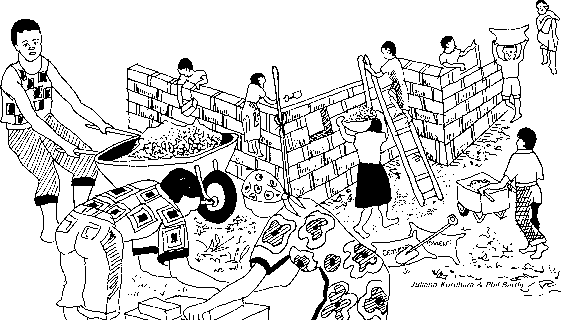Tweet
Translations:
'العربية / al-ʿarabīyah
Bahasa Indonesia
Català
中文 / Zhōngwén
Deutsch
English
Español
Ewe
Filipino/Tagalog
Français
Galego
Ελληνικά / Elliniká
हिन्दी / hindī
Italiano
日本語 / Nihongo
한국어 / Hangugeo
بهاس ملايو / Bahasa Melayu
Polszczyzna
Português
Română
Русский
Српски / Srpski
తెలుగు /Telugu
ไทย / Thai
Tiếng Việt
Türkçe
اردو / Urdu
Other formats:
Other Pages:
Modules
Site Map
Key Words
Contact
Utility Documents
Useful Links
PROJECT DESIGN, PROPOSALS, OUTSIDE RESOURCES
Designing a Project and Getting Resources For It
by Phil Bartle, PhD
Training Handout
When helping the community to decide on the details of their chosen project, you must balance the tendency to get too many outside resources, thus encouraging dependency and sustaining poverty, in contrast to depending upon internal resources (difficult), thus becoming more empowered and self reliant
Remember that your job is to fight dependency, where community members come to rely on outside assistance for community improvements. Your emphasis should be on community self reliance (where the community relies mainly on its own resources).
If the community chooses an expensive project, and cannot expect to raise enough money, you must caution them to be more realistic (not to depend upon outside charity).
A proposal is a request for funds from a potential donor. The best proposal is designed like a project design, which serves to justify to the donor why it should donate funds.
The same project action plan should be the basis for submitting to higher levels of Government to access ceded funds.
Do not do the work of the committee, however tempted you are. The executive must learn by doing. Illiterates on the committee must be fully involved in its preparation, verbally, line by line.
A project design can be used as a proposal for obtaining outside funds. It must be used for getting the approval of the whole community for undertaking the project. In that sense it is still a kind of proposal. It might be required by district authorities; it surely is advisable to give them a copy.
The essence of the project design, like the brainstorm, is to systematically answer The Four Key Questions, (what do we want, what do we have, how can we use what we have to get what we want, and what will happen if we do). It is your duty, as mobilizer, to go through these four key questions in detail with the executive, putting them into the relevant context, and systematize the answers into an appropriate document to be written by the executive.
When discussing resources, you will often hear executive members saying that the community does not have enough funds. There is a tendency to rely on one outside donor only. Relying on only one source increases vulnerability, thus decreases the strength of the community. With some effort, community members can pull in resources from many and varied sources. See Resource Acquisition.
The mobilizer does not dictate to the community that all these must be provided by the community. Instead, you can mention all of these, and ask the community members to identify those which the community can provide.
- Donations: cash, land, buildings, supplies and equipment, donated by individuals who want to support their community. (Acknowledged and thanked in public meetings);
- Commercial: gifts from firms and businesses that want to advertise their good will and support of the community. (Acknowledged and thanked in public meetings);
- Communal Labour: time and labour donated by community members, some unskilled (clearing grass, laying bricks), some skilled (carpentry, masonry), meetings, planning, monitoring, supervision;
- Agricultural: farmers may donate food for the project:
- to communal workers who are working on the project, or
- to the executive committee to sell to raise cash for the project;
- Food: people who donate the preparing of food and refreshments to the community members on communal working days;
- Contributions and fees: for credit club and similar financial projects, contributions from all members; service fees, such as for obtaining water;
- Governmental: partial funding from central, district or local governmental sources. Sources may include district development committee participation;
- Non Governmental Organizations (NGOs): local community based organizations, churches, outside NGOs working locally; and
- Anonymous Donors: benefactors who remain unknown.
This list is not complete. Seek suggestions in brain storming sessions with community members (not only leaders).
See Funds for more details about obtaining resources for community projects.
––»«––
Community Contribution; Construction
 |